The Normandy Region in France goes along the English Channel and is known for its historical significance, the D-Day Beaches, the famous Mont Saint-Michel, countryside, coastlines, Norman architecture, gastronomy, events, festivals, art, and literature. The Normandy region played a big role in European history because it was used for the Allied D-Day landings during World War II.
The Loire Valley Region in France, known as the Garden of France, is famous for its scenic landscapes full of color, the many castles (châteaux), wine production, prehistoric times history, cultural heritage, the Loire River known as the longest river in France, and many festivals and events throughout the year. The Loire Valley Region is a UNESCO World Heritage Site.
Are you looking for a tour to visit the Normandy and Loire Valley Regions in France?
We offer tours that include hotel, breakfast, and activities.
Request a free quote online. Contact us.
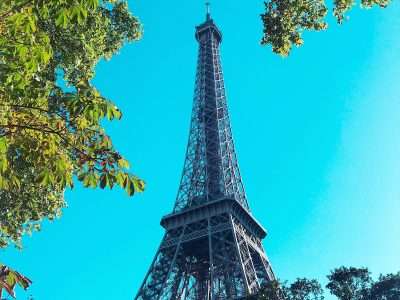
Paris, the City of Lights, has a long cultural history. Its museums are home to some of the top world-class items, including the Mona Lisa and the Musée d’Orsay. The Eiffel Tower and the Notre Dame Cathedral are two of the most iconic architectures. In Paris, you can find varieties of pastries, cheeses, wines, and gourmet national and international cuisine.
Paris offers a romantic ambiance, making it a top destination for couples.
Address: Paris, France

The region of Normandy is of historical importance. The most popular destination, the Mont Saint-Michael, is a UNESCO World Heritage site and a must-visit for its beauty and history. The region is blessed with many stunning castles (chateaux) and impressive gardens.
Address: Normandy, France
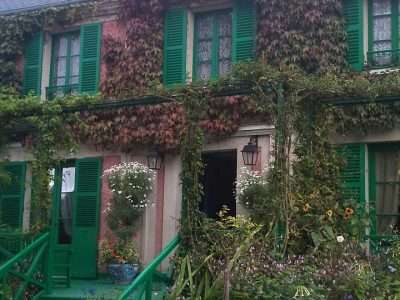
The House of Claude Monet was the house of the French impressionist painter Claude Monet. The house has many different ambiances. Claude Monet had his own apartment in the house with a bathroom and a large bedroom. The blue sitting room has vibrant blues and a collection of 231 Japanese woodblocks. A small pantry is located at the entrance, and it can store around 116 eggs. Other parts of the house that you can see are the first studio of Claude Monet, which later became his smoking room and visitor’s room, Clause Monet’s bedroom, Alice Monet’s bedroom, the dining room, and the kitchen.
It’s open only from April until September.
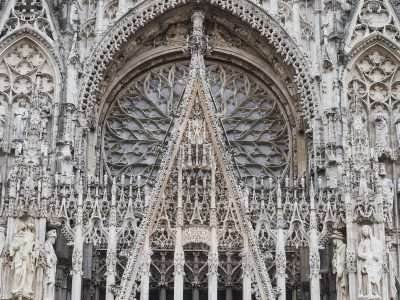
Cathédrale Notre-Dame de Rouen was completed in 1506, and it suffered partial destruction during WWII, a fire in 1940, and the Royal Air Force bombings of 1955. The cathedral has a Gothic architecture with many statues, stone carvings, and stained glass windows. The cathedral inside has high ceilings and distinctive chapels.
Joan de Arc was sentenced to death in Rouen, and the cathedral played an important part in the event.
The French impressionist painter Claude Monet painted the cathedral at different times of the day to capture the many lights produced by the architecture.
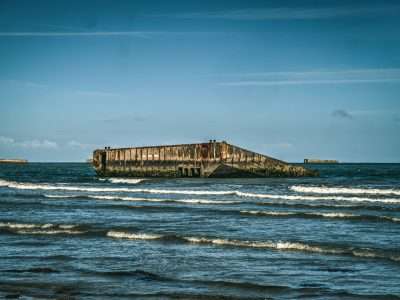
Arromanches-les-Bains is a comune in the Normandy Region of north-western France that was used as a strategic port by Winston Churchill. Arromanches received over 2.5 million men, four million tonnes of supplies, and around 500,000 vehicles during the British wartime.
Nowadays, Arromanches is a well-known seaside resort where visitors can learn more about World War II history through the Musée du Débarquement (D-Day Museum) and the remnants of the Mulberry harbor.
Address: Arromanches-les-Bains, France
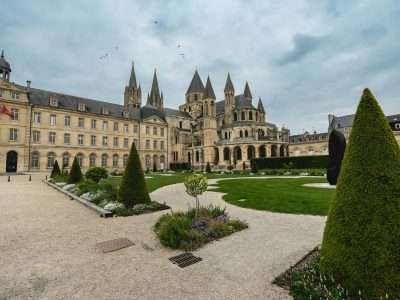
Caen is a port city that shows medieval times history. Some of the city’s main landmarks are William the Conqueror’s Castle and the remnants of two Romanesque abbeys: Saint-Étienne and Sainte-Trinité.
William the Conqueror lived in Caen and founded two churches: the Abbaye aux Hommes (Men’s Abbey) and the Abbaye aux Dames (Women’s Abbey) that were originally built to ask the Pope’s forgiveness for marrying his distant cousin Matilda de Flanders.
The Université de Caen Normandie in Caen is one of the oldest universities in France, dating back to the 15th century.
Address: 14000 Caen, France
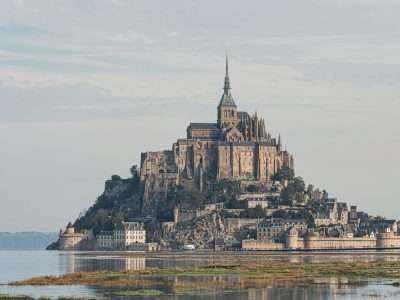
The Mont Saint-Michel is an island but within a waterbody, a raised area, and approximately one kilometer away from the country’s northwestern coast.
The Abbey of Mont Saint Michel, built in the 8th century, is one of the main attractions on the island. It combines Gothic and Romanesque styles, and it is a UNESCO World Heritage site.
Can you visit Mont Saint Michel at any time?
There is a village in Mont Saint Michel that is open all the time without a reservation or ticket. However, to enter the Abbey of Mont Saint Michel, you will need to buy a ticket.
Who lives in the Mont Saint Michel Abbey?
The monks and nuns from the Monastic Fraternities of Jerusalem have lived in the Mont Saint Michel Abbey since 2001.
Who lives in Mont Saint Michel village?
The small village is home to a French commune, including a postman, a mayor, policemen, waste services, and a community of cats.
Address: 50170 Mont Saint-Michel, France

Saint-Malo is a port city in the Brittany Region. One of the most famous tourist attractions is the Intra-Muros, located at the center of the city, where you can find the Saint-Malo Cathedral and the Château de Saint-Malo. The fortifications of the city are also an impressive attraction built to protect the city from invasions. You can also enjoy panoramic views from the walls and ramparts around the city.
Saint-Malo is the most visited city in the Brittany Region, with many granite structures, sandy beaches such as the Plage de l’Éventail and the Plage du Môle, and the Solidor Tower, where the Saint-Malo Maritime Museum.
Address: Saint-Malo, France
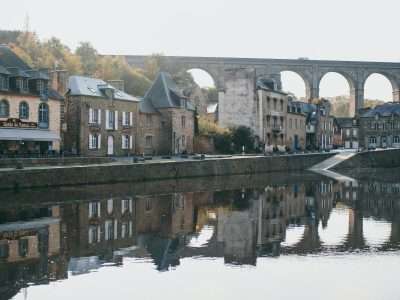
Dinan is a town in the Brittany region where you will find well-maintained medieval architecture. It can be considered a medieval town with its cobbled streets and its location along the Rance River.
The Château de Dinan (castle) offers panoramic views of the town.
Medieval ramparts surround the town and make it easy to walk around the town while enjoying scenic views.
The Jerzual Street connects the upper town with the lower port area.
The Basilique Saint-Sauveur is a church in Dinan with a Gothic style.
Does Dinan have a train station?
Yes, the Dinan station has been in the town of Dinan since 1879. There is also a railway museum since 1991.
Address: 22100 Dinan, France

Rennes is the capital city of Brittany and has an ancient history from the Roman times. You will find cobblestone streets with medieval houses and the iconic square called Place des Lices, where there is a morning market every Saturday.
The most relevant places in Rennes are the Parliament of Brittany, the Thabor Gardens, the Rennes Cathedral (Cathédrale Saint-Pierre de Rennes), the University of Rennes 1, the University of Rennes 2, and many cultural events and festivals such as an international music festival.
Address: Rennes, France
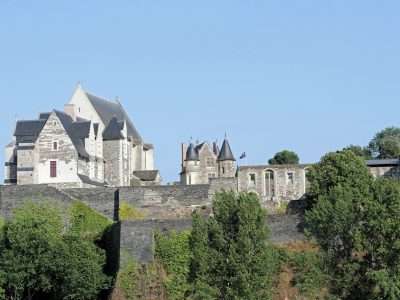
Angers is a city at the edge of the Loire Valley. Angers is also known as the capital of the Maine-et-Loire department.
Places to visit:
Address: Angers, France
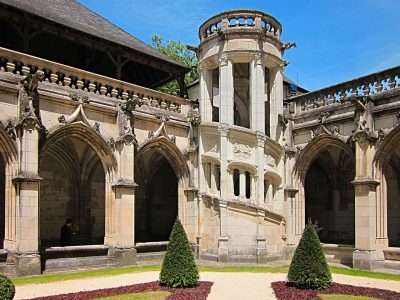
Tours is the largest city found in the Centre-Val de Loire. It’s considered a city of art and history.
In Tours, you will find:
What food is famous in Tours?
The gastronomy of Tours involves the rillons and the wine produced by the Chenin Blanc grapes. The rillons is a winter pork recipe.
Address: Tours, France

The Château de Villandry is a famous castle in Villandry close to Tours city in the Loire Valley. It’s a UNESCO World Heritage Site built by Jean Le Breton. Renaissance architecture combines medieval and classical features.
The gardens in the Château de Villandry cover an area of approximately 6 hectares and are divided into different sections. There are terraces that offer panoramic views of the gardens and the countryside surrounding the castle.
Throughout the year, there are many concerts, festivals, and personalized tours being held in the Château de Villandry.
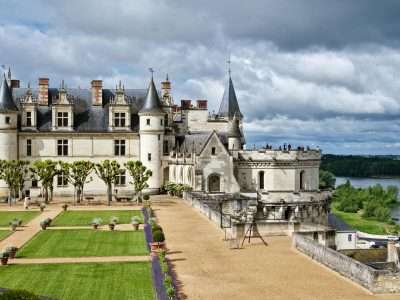
Amboise is a town in the Loire Valley. The Château d’Amboise is a castle of Renaissance architecture that was used as a royal castle for King Charles VIII.
Leonardo da Vinci was living in Amboise in his last years, and his tomb can be found in the Chapel of Saint Hubert, which is inside the castle grounds. Leonardo da Vinci was living in the mansion Clos Lucé, which is now a museum showing his work and life.
Address: 37400 Amboise, France
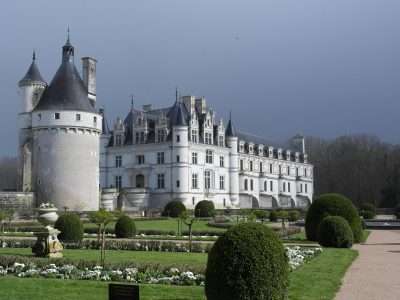
Château de Chenonceau is a castle located in the small village of Chenonceaux in the Centre-Val de Loire region. Why is Château de Chenonceau called the Castle of the Ladies? It is also known as the Ladies’ Castle (Château des Dames) because many women formed part of its history. Diane de Poitiers, the mistress of King Henry II, and Catherine de’ Medici, the queen consort of King Henry II, influenced the development of the castle.
There are many gardens around the Château de Chenonceau, such as the Diane de Poitiers’ Garden, Catherine de’ Medici’s Garden, and the Flower Garden.
The Gallery Bridge is an important part of the castle. It consists of a two-story gallery built by Catherine de’ Medici that offers scenic views of the river.
What was the significance of Château de Chenonceau during the First World War?
The castle was used as a military hospital from 1914 to 1918.
Address: 37150 Chenonceaux, France
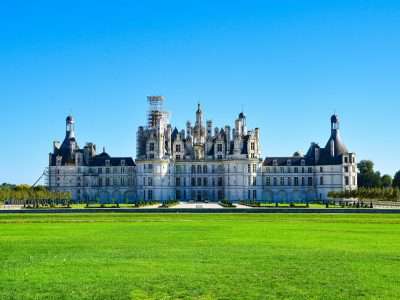
The Château de Chambord is a castle located in the Centre-Val de Loire region. It forms an important part of the French Renaissance. The castle was ordered to be constructed by King Francis I, but it was not finished during his reign; the following monarchs finished the castle, and it was used as a hunting lodge and a symbol of the king’s power.
What is special about the staircase of Le Château de Chambord? The staircase has a double helix structure, which is about a central core that is hollow, and it can be twisted to use the stair to access the main floors in a way that two people or more can use the stair at the same time without meeting each other. This type of structure is similar to the Leonardo da Vinci sketches.
Address: 41250 Chambord, France
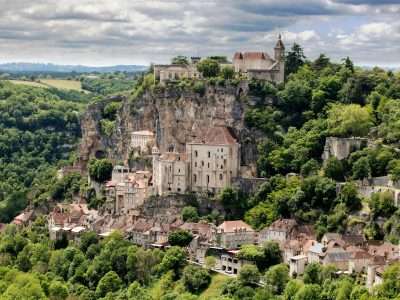
Chemin de Croix in Rocamadour village, also known as the Way of the Cross or Via Crucis, is a path about the traditional Stations of the Cross referring to a series of events that happened during the Passion of Jesus Christ from the condemnation to the crucifixion and burial.
Rocamadour is a small village on a clifftop that was also known as a medieval pilgrimage site in France.
The Stations of the Cross in the Chemin de Croix path leads from the Grand Staircase to the Sanctuary at the end. In Station I, called the Jesus is Condemned to Death, you can begin ascending the Grand Staircase. In Stations II to XIV, you will find chapels and alcoves with panoramic views along the way.
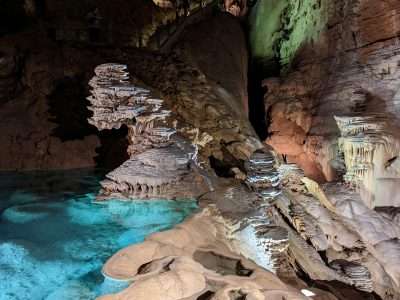
Gouffre de Padirac is a cave with a subterranean river system that can be partially explored by boat. You will also find stalactites and stalagmites while learning about the geological formation. There is a small underground Cathedral called Salle du Grand Dôme that produces original acoustics.
Gouffre de Padirac is typically open from Spring to Autumn.
How old is the Gouffre de Padirac? The cave was opened to the public in 1898, but Édouard-Alfred Martel first explored it.
How deep is the Gouffre de Padirac? The cave is about 103 m (338 ft) deep, and visitors can descend to 75 m using a combination of a staircase system and elevators.
Address: Le Gouffre, 46500 Padirac, France

The Limoges Cathedral (Cathédrale Saint-Étienne de Limoges, also known as the Gothic Cathedral Quarter) is a Roman Catholic cathedral in the historic center of the city. The architectural styles combine Romanesque and Gothic features. The cathedral has a bell tower with an octagonal shape and capped with a spire. A crypt containing relics of Saint Martial from the 10th century and a pipe organ are inside the cathedral.
Address: Place de la Cathédrale, Pl. Saint-Étienne, 87000 Limoges, France
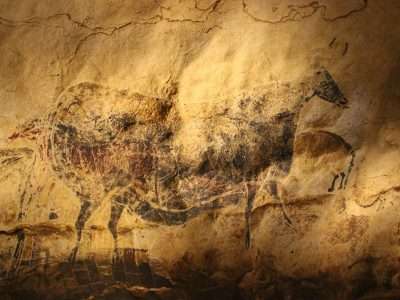
Lascaux International Center of Parietal Art is a museum dedicated to an identical replica of the original Lascaux Cave paintings, which had to be closed due to environmental issues.
The paintings inside the cave date back approximately 17,000 years ago and include animals, humans, and abstract symbols.
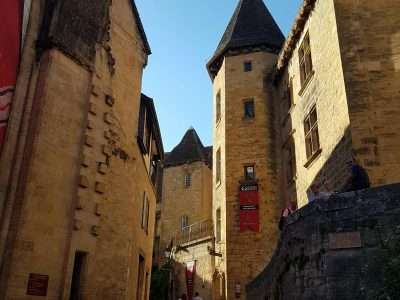
Sarlat-la-Canéda is a medieval town surrounded by the Dordogne River. It is known as the Town of Art and History. Places to visit include:
Address: Sarlat-la-Canéda, 24200, France
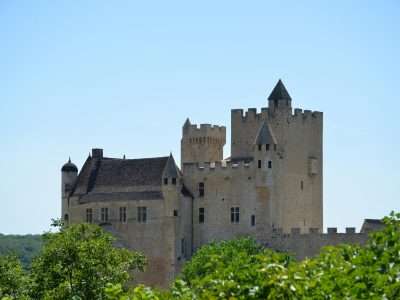
Château de Beynac is a medieval castle with scenic views of the Dordogne Valley. When you explore the castle, you will see the impressive courtyard, the Great Hall, the chapel, the many bedrooms, kitchens, dungeon, and other defensive structures.
You can also learn about the life of the castle’s inhabitants and take a walk along the castle’s ramparts.
Address: Le Château de Beynac, Place du château, 24220 Beynac-et-Cazenac, France

Collonges-la-Rouge is a comune well known for its well-preserved red sandstone buildings. If you are looking for a medieval experience, visit this village in France known as the Les Plus Beaux Villages de France (The Most Beautiful Villages of France). Places to visit include:
Address: 19500 Collonges-la-Rouge, France
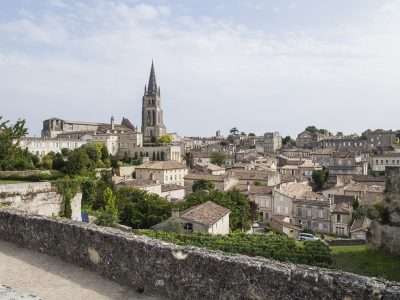
Saint-Émilion is a comune known as one of the main red wine areas that also have well preserved medieval architecture. Things to do and visit in Saint-Émilion:
Address: Saint-Émilion, France
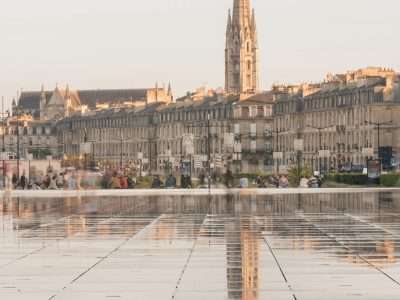
The Miroir d’Eau, also known as the Water Mirror), is a reflecting pool in front of the Place de la Bourse. The Water Mirror was inaugurated in 2006. Free admission to enjoy the Water Mirror.
What is the most photographed site in Bordeaux? The Miroir d’Eau (Water Mirror) is considered the most photographed site in Bordeaux; it is a UNESCO World Heritage Site with one of the largest reflecting pools in the world, covering an area of about 3,450 square meters.
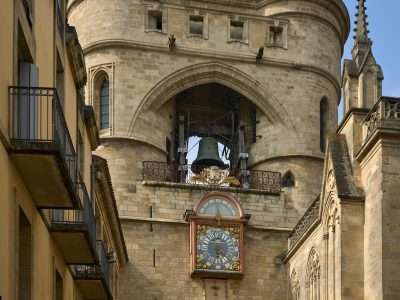
Also known as the Port de la Lune (Port of the Moon) by UNESCO since 2007, the Bordeaux Old Town has many mansions, neo-classical squares, boulevards, museums, and a shopping district.
There are more than 5,000 houses from the 18th century and a high number of historic monuments.
Places to visit in the Bordeaux Old Town:
Address: 33000 Bordeaux, France
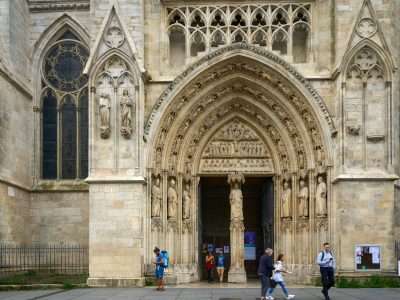
The Saint Andrew’s Cathedral of Bordeaux (Cathédrale Saint-André de Bordeaux) is a Roman Catholic cathedral from the 12th century located in the heart of Bordeaux. It combines Northern and Southern Gothic styles.
The Pey-Berland Tower is a bell tower separated from the cathedral that was constructed in the 15th century and allows visitors to enjoy a scenic view of the city.
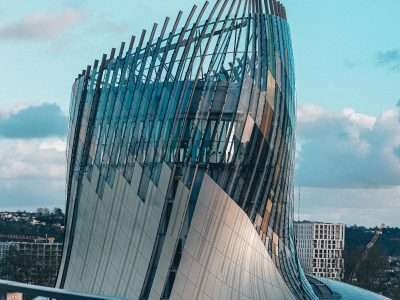
La Cité du Vin is a museum and a wine-themed cultural complex due to its architecture that resembles a wine swirling in a glass. In the museum, you can learn about the history, culture, and significance of the world of wine for different societies.
Visitors can enjoy wine-tasting samples from different places of the world as well as a panoramic view of the Garonne River on the Belvedere floor, which also offers culinary experiences.
Stay up-to-date with our latest travel content. Also, we can send you our special discounts and promotions that are available throughout the year. We’ll be happy to help you travel to your desired destination.
Social Chat is free, download and try it now here!

Post Discussion